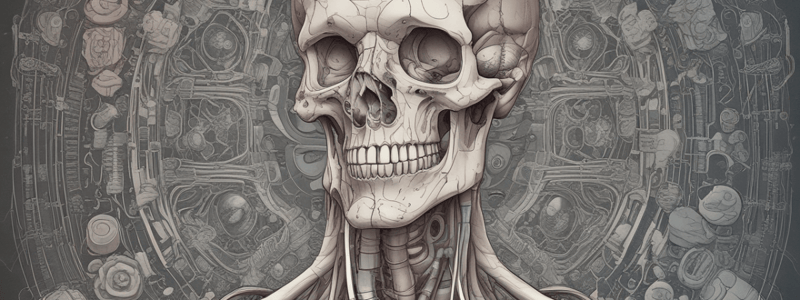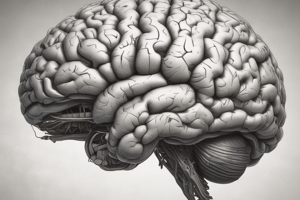Podcast
Questions and Answers
Match the brain vesicles with their corresponding divisions:
Match the brain vesicles with their corresponding divisions:
Prosencephalon = Divides into telencephalon and diencephalon Rhombencephalon = Divides into metencephalon and myelencephalon Mesencephalon = Does not divide Neural tubes = Divides into primary brain vesicles
Match the brain regions with their corresponding functions:
Match the brain regions with their corresponding functions:
Telencephalon = Higher cognitive functions Diencephalon = Regulation of body temperature and hunger Metencephalon = Forms the pons and overlying cerebellum Myelencephalon = Forms the medulla oblongata
Match the neural pathways with their corresponding functions:
Match the neural pathways with their corresponding functions:
Ascending sensory pathway = Responsible for sensations Descending motor pathway = Responsible for motor control Pyramidal system = Conscious motor control Spinocerebellar pathway = Unconscious motor coordination
Match the brain regions with their corresponding developmental stages:
Match the brain regions with their corresponding developmental stages:
Match the brainstem structures with their corresponding functions:
Match the brainstem structures with their corresponding functions:
Match the neural pathways with their corresponding components:
Match the neural pathways with their corresponding components:
Match the type of tracts with the information they transmit:
Match the type of tracts with the information they transmit:
Match the locations with the type of inputs they receive:
Match the locations with the type of inputs they receive:
Match the cranial nerves with their attachment location:
Match the cranial nerves with their attachment location:
Match the systems with their function:
Match the systems with their function:
Match the tracts with their pathways:
Match the tracts with their pathways:
Match the function with the location:
Match the function with the location:
Match the brain stem nuclei with their corresponding components:
Match the brain stem nuclei with their corresponding components:
Match the midbrain divisions with their corresponding components:
Match the midbrain divisions with their corresponding components:
Match the following brain regions with their connections:
Match the following brain regions with their connections:
Match the brain stem nuclei with their corresponding functions:
Match the brain stem nuclei with their corresponding functions:
Match the midbrain structures with their corresponding components:
Match the midbrain structures with their corresponding components:
Match the following cranial nerves with their location of emergence:
Match the following cranial nerves with their location of emergence:
Match the brain stem components with their corresponding functions:
Match the brain stem components with their corresponding functions:
Match the following brain regions with their locations:
Match the following brain regions with their locations:
Match the brain stem structures with their corresponding locations:
Match the brain stem structures with their corresponding locations:
Match the following fibre tracts with their origin:
Match the following fibre tracts with their origin:
Match the following brain regions with their organization:
Match the following brain regions with their organization:
Match the following cranial nerve nuclei with their location:
Match the following cranial nerve nuclei with their location:
Match the brainstem structures with their corresponding nuclei:
Match the brainstem structures with their corresponding nuclei:
Match the brain regions with their corresponding characteristics:
Match the brain regions with their corresponding characteristics:
Match the brainstem structures with their corresponding neurons:
Match the brainstem structures with their corresponding neurons:
Match the brain regions with their corresponding functions:
Match the brain regions with their corresponding functions:
Match the brainstem structures with their corresponding locations:
Match the brainstem structures with their corresponding locations:
Match the brain regions with their corresponding diseases:
Match the brain regions with their corresponding diseases:
Flashcards are hidden until you start studying
Study Notes
Brain Vesicles and Divisions
- Prosencephalon (Forebrain): Telencephalon and Diencephalon
- Mesencephalon (Midbrain): Remains as midbrain
- Rhombencephalon (Hindbrain): Metencephalon and Myelencephalon
Brain Regions and Functions
- Cerebrum: Higher-order functions, including sensory perception, motor control, language, and memory
- Cerebellum: Coordination, balance, and motor learning
- Brainstem: Controls essential life functions such as breathing, heart rate, and blood pressure
- Diencephalon: Relay center for sensory information and regulates homeostasis
- Spinal Cord: Relays sensory information to the brain and motor commands from the brain to the muscles
Neural Pathways and Functions
- Ascending Tracts: Carry sensory information from the periphery to the brain
- Descending Tracts: Carry motor commands from the brain to the periphery
- Corticospinal Tract: Controls voluntary movement
- Spinothalamic Tract: Carries pain and temperature information
- Dorsal Column-Medial Lemniscus Pathway: Carries touch and proprioception information
Brain Regions and Developmental Stages
- Telencephalon: Develops into the cerebral cortex, basal ganglia, and limbic system
- Diencephalon: Develops into the thalamus, hypothalamus, and epithalamus
- Metencephalon: Develops into the pons and cerebellum
- Myelencephalon: Develops into the medulla oblongata
Brainstem Structures and Functions
- Medulla Oblongata: Controls vital functions such as breathing, heart rate, and blood pressure
- Pons: Relays information between the cerebrum and cerebellum
- Midbrain: Controls eye movements, auditory processing, and motor control
Neural Pathways and Components
- Ascending Pathways: Include the spinothalamic tract, dorsal column-medial lemniscus pathway, and spinocerebellar tracts
- Descending Pathways: Include the corticospinal tract, rubrospinal tract, and vestibulospinal tract
Types of Tracts and Information Transmission
- Sensory Tracts: Carry sensory information from the periphery to the brain
- Motor Tracts: Carry motor commands from the brain to the periphery
- Association Tracts: Connect different areas within the same hemisphere of the brain
Locations and Types of Inputs
- Sensory Cortex: Receives sensory information from the periphery
- Motor Cortex: Receives input from the basal ganglia and cerebellum
- Association Cortex: Receives input from various sensory and motor areas
Cranial Nerves and Attachment Location
- Olfactory Nerve (I): Attaches to the olfactory bulb
- Optic Nerve (II): Attaches to the diencephalon
- Oculomotor Nerve (III): Attaches to the midbrain
- Trochlear Nerve (IV): Attaches to the midbrain
- Trigeminal Nerve (V): Attaches to the pons
- Abducens Nerve (VI): Attaches to the pons
- Facial Nerve (VII): Attaches to the pons
- Vestibulocochlear Nerve (VIII): Attaches to the pons
- Glossopharyngeal Nerve (IX): Attaches to the medulla oblongata
- Vagus Nerve (X): Attaches to the medulla oblongata
- Accessory Nerve (XI): Attaches to the medulla oblongata and spinal cord
- Hypoglossal Nerve (XII): Attaches to the medulla oblongata
Systems and Their Function
- Somatic Nervous System: Controls voluntary movement
- Autonomic Nervous System: Controls involuntary functions such as heart rate, breathing, and digestion
- Sympathetic Nervous System: Activates the "fight-or-flight" response
- Parasympathetic Nervous System: Promotes "rest-and-digest" functions
Tracts and Pathways
- Ascending Tracts: Travel upwards towards the brain
- Descending Tracts: Travel downwards towards the spinal cord
Function and Location
- Cerebral Cortex: Higher-order functions, located in the outermost layer of the cerebrum
- Hypothalamus: Regulates homeostasis, located below the thalamus
- Thalamus: Relays sensory information, located in the diencephalon
Brainstem Nuclei and Components
- Red Nucleus: Involved in motor control, located in the midbrain
- Substantia Nigra: Involved in movement, located in the midbrain
- Reticular Formation: Regulates arousal and sleep, extends throughout the brainstem
Midbrain Divisions and Components
- Tectum: Includes the superior and inferior colliculi, involved in visual and auditory reflexes
- Tegmentum: Includes the red nucleus, substantia nigra, and reticular formation
Brain Regions and Connections
- Cerebral Cortex: Connected to the thalamus, basal ganglia, and cerebellum
- Thalamus: Connected to the cerebral cortex, brainstem, and spinal cord
Brainstem Nuclei and Their Functions
- Nucleus Gracilis: Receives touch and proprioception information from the lower body
- Nucleus Cuneatus: Receives touch and proprioception information from the upper body
- Dorsal Motor Nucleus of the Vagus Nerve: Controls parasympathetic functions of the heart, lungs, and digestive system
Midbrain Structures and Components
- Superior Colliculi: Involved in visual reflexes
- Inferior Colliculi: Involved in auditory reflexes
Cranial Nerves and Location of Emergence
- Olfactory Nerve (I): Emerges from the olfactory bulb
- Optic Nerve (II): Emerges from the diencephalon
- Oculomotor Nerve (III): Emerges from the midbrain
- Trochlear Nerve (IV): Emerges from the midbrain
- Trigeminal Nerve (V): Emerges from the pons
- Abducens Nerve (VI): Emerges from the pons
- Facial Nerve (VII): Emerges from the pons
- Vestibulocochlear Nerve (VIII): Emerges from the pons
- Glossopharyngeal Nerve (IX): Emerges from the medulla oblongata
- Vagus Nerve (X): Emerges from the medulla oblongata
- Accessory Nerve (XI): Emerges from the medulla oblongata and spinal cord
- Hypoglossal Nerve (XII): Emerges from the medulla oblongata
Brainstem Components and Functions
- Medulla Oblongata: Controls vital functions such as breathing, heart rate, and blood pressure
- Pons: Relays information between the cerebrum and cerebellum
- Midbrain: Controls eye movements, auditory processing, and motor control
Brain Regions and Locations
- Cerebrum: The largest part of the brain, located in the anterior portion of the skull
- Cerebellum: Located at the back of the brain, below the cerebrum
- Brainstem: Connects the cerebrum to the spinal cord, located in the central portion of the brain
Brainstem Structures and Locations
- Medulla Oblongata: The lowest part of the brainstem, located just above the spinal cord
- Pons: Located above the medulla oblongata
- Midbrain: Located above the pons
Fibre Tracts and Origin
- Corticospinal Tract: Originates from the cerebral cortex
- Spinothalamic Tract: Originates from the spinal cord
- Dorsal Column-Medial Lemniscus Pathway: Originates from the spinal cord
Brain Regions and Organization
- Cerebral Cortex: Organized into lobes, each responsible for specific functions
- Cerebellum: Organized into hemispheres, each controlling movement on the opposite side of the body
- Brainstem: Organized into nuclei, each responsible for specific functions
Cranial Nerve Nuclei and Location
- Oculomotor Nucleus: Located in the midbrain
- Trigeminal Nucleus: Located in the pons
- Hypoglossal Nucleus: Located in the medulla oblongata
Brainstem Structures and Corresponding Nuclei
- Medulla Oblongata: Contains the nucleus gracilis, nucleus cuneatus, and dorsal motor nucleus of the vagus nerve
- Pons: Contains the trigeminal nucleus and abducens nucleus
- Midbrain: Contains the red nucleus and substantia nigra
Brain Regions and Characteristics
- Cerebrum: Characterized by its complex gyri and sulci
- Cerebellum: Characterized by its folia and arbor vitae
- Brainstem: Characterized by its reticular formation and nuclei
Brainstem Structures and Corresponding Neurons
- Medulla Oblongata: Contains motor neurons that control breathing, heart rate, and blood pressure
- Pons: Contains motor neurons that control facial expressions and eye movements
- Midbrain: Contains motor neurons that control eye movements and motor control
Brain Regions and Functions
- Cerebrum: Higher-order functions, including sensory perception, motor control, language, and memory
- Cerebellum: Coordination, balance, and motor learning
- Brainstem: Controls essential life functions such as breathing, heart rate, and blood pressure
Brainstem Structures and Locations
- Medulla Oblongata: The lowest part of the brainstem, located just above the spinal cord
- Pons: Located above the medulla oblongata
- Midbrain: Located above the pons
Brain Regions and Diseases
- Cerebrum: Stroke, Alzheimer's disease, Parkinson's disease
- Cerebellum: Cerebellar ataxia
- Brainstem: Brainstem stroke, multiple sclerosis
Studying That Suits You
Use AI to generate personalized quizzes and flashcards to suit your learning preferences.




